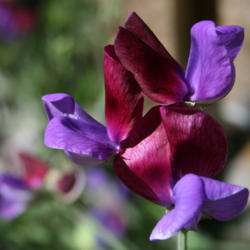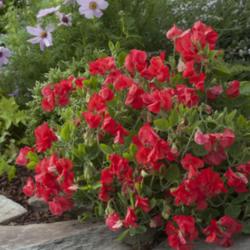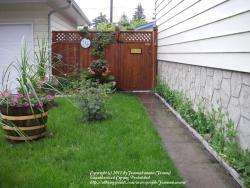Sweet Peas originate from the Mediterranean and are naturally an early spring bloomer. Blooming period is extended with cooler temperatures, but once the heat of summer sets in, sweet peas are at the end of their natural life cycle. The life cycle is complete in one year. Seeds germinate in late fall or early winter with slow top growth for a few months. It may seem that they have stalled, but there is lots happening under ground. They need this long cool growing period to develop a strong root system. As spring approaches, the days become longer, a trigger for top growth. The sweet peas start a rapid growth period and flower buds form with 12 to 15 hours of daylight. Late spring/early summer heat initiates pod formation and as the days get hotter, the pods ripen and the plant dies. The tough seed coat is key for the seed to stay dormant until the conditions are favorable for the cycle to start again in the fall.

Many different growth habits are available from 10” dwarf mounding varieties to vigorous 8’ tall vines. Vines will require support with netting or stakes for the tendrils to attach to, including the 2’ to 3’ vine varieties. Dwarf varieties are well suited for containers or border planting. Inter-planting short and tall vines produce a wonderful wall of colour from bottom to top.
There is a wide range of colours offered in today’s market. Blue, pink, purple, red, white, and even orange are available in either mixes or individually. No yellow though. Bi-colours with unique patterns also offer a beautiful option for streaks, stripes, flecked and edged flowers. The Spencer varieties have large ruffled flowers. Some varieties have up top 5 flowers per stem.
Most varieties are fragrant, but do check the seed package description. Often the larger flower varieties have a mild fragrance. If there is no mention of fragrance, chances are they may have little to none. Many of the most fragrant varieties have small flowers. Look for scent or fragrance descriptions within the variety name or on the seed package. Typically the white and pink colors are the most fragrant in mixes. Heirloom or Heritage varieties are often highly fragrant. One of the oldest varieties that is still available is “Painted Lady” cultivated since the 1700’s. I planted Mammoth which was a bit disappointing since the scent was very light. The flowers were early and pretty though.
Sweet Peas prefer cool temperatures for both germination and seasonal growth. There are numerous varieties with different growth habits that are bred for heat tolerance. In hot conditions, choose a planting area that has afternoon shade. East exposure may be an excellent option providing early morning sun and shade during the hottest part of the day. Heat tolerant varieties like Villa Roma Scarlet (fragrant dwarf) are great choice for hot conditions.

Choosing the most appropriate bloom season will be the success for your sweet peas. Most sweet peas require more than 12 hours of daylight, but there are now some new varieties that are semi daylight neutral, which will produce flowers with shorter day lengths. Here are some examples:
Very Early (daylight neutral): Winter Sunshine, Elegance, Lunar and Equinox.
Early (semi-daylight neutral): Mammoth, Streamers and Royals, a bit later
Later (daylight sensitive): Spencers and Cuthbertosons.
Spring, Summer, or Fall Blooms for Your Garden
If your ground doesn’t freeze during winter, direct sow in October for blooms in late winter to early spring. This is about the same time you would plant your fall bulbs. They will germinate within a few weeks and have slow growth for a few months. If your area skips spring (gets early season hot temperatures) you may want to start them indoors to speed up germination and transplant out. In both situations, choose varieties that are not daylight sensitive, since the days will be less than 12 hours daylight at that time of year. Look for variety descriptions to include: Short Day Flowering, Very Early to Flower or Winter Sweet Peas.
If you have mild winter conditions and an early spring, direct sow two crops. Sow one crop in the fall and the second crop as soon as the ground can be worked in the spring (6 to 8 weeks before average last frost). Winter sowing technique in milk jugs would be a great option as well. Remember, the plants will have slow top growth for the first 6 weeks, which is normal. Expect blooms about 12 to 14 weeks after germination with over 12 hours daylight.
For the folks with severe winter conditions and cool summers, starting the seeds indoors with cool growing conditions 6 -8 weeks before last frost will give you early summer blooms. Direct sowing as soon as the ground can be worked will produce August blooms. Winter sowing techniques will give you about a month earlier bloom than direct sowing. Planting a combination of very early, early and late varieties will give you blooms all season until frost.
Seed Sowing & Growing
 |
 |
 |
| Late May (Average Last Frost is May 23rd, Started early indoors in March) | Early July (Blooms have started) | Mid September (After hail storms, summer heat and a few frosts, they are still going) |
I hope this information helps you choose the best sweet peas for your garden.
| Thread Title | Last Reply | Replies |
|---|---|---|
| Sweet Peas by valleylynn | Oct 12, 2017 6:14 AM | 21 |